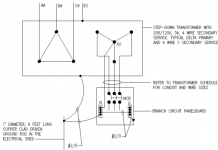hhsting
Senior Member
- Location
- Glen bunie, md, us
- Occupation
- Junior plan reviewer
Below is what I received as transformer grounding detail. It has not supply side bonding jumper instead the engineer has conductor bonded from the transformer to the ground rod. To me conductor from Transformer to ground rod is not in compliance with NEC 2017 Article 250.4(A)(5) and also transformer enclosure cannot be used as equipment grounding conductor path NEC 2017 Article 250.118, 450..10. I am not sure if this would be in compliance with NEC 2017 and would like to know what your thoughts are in regard to if this is acceptable or not?




